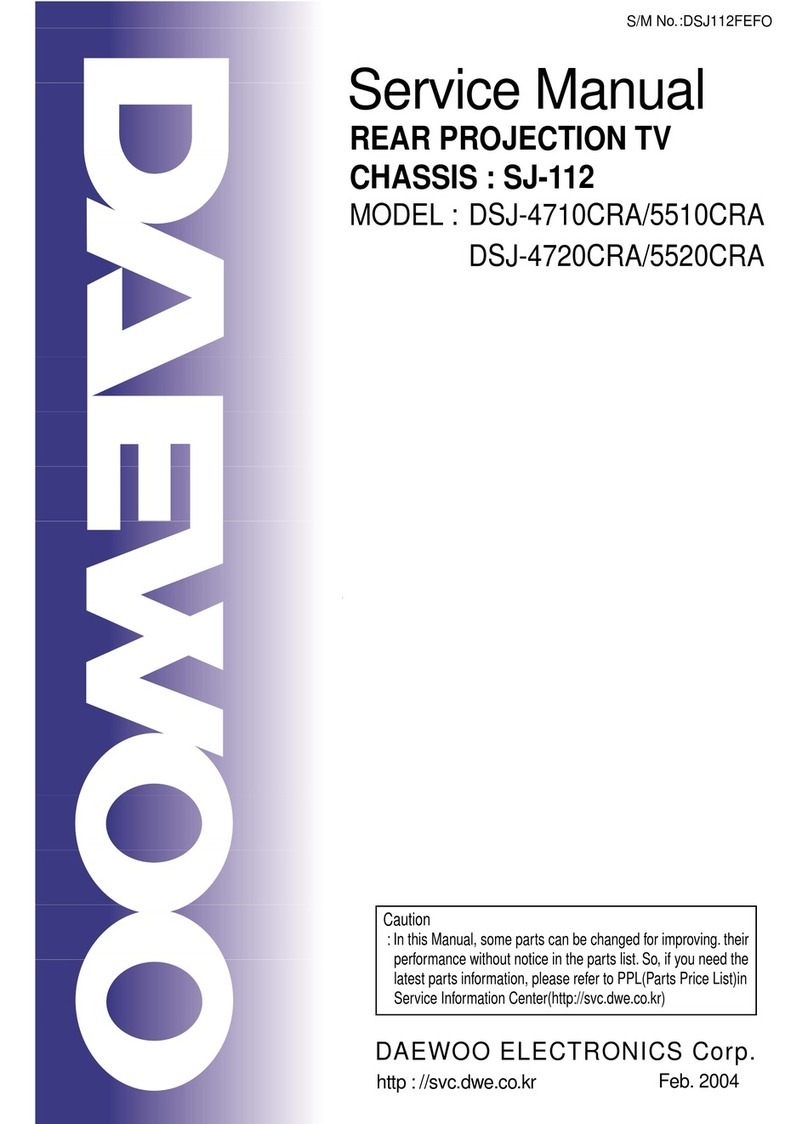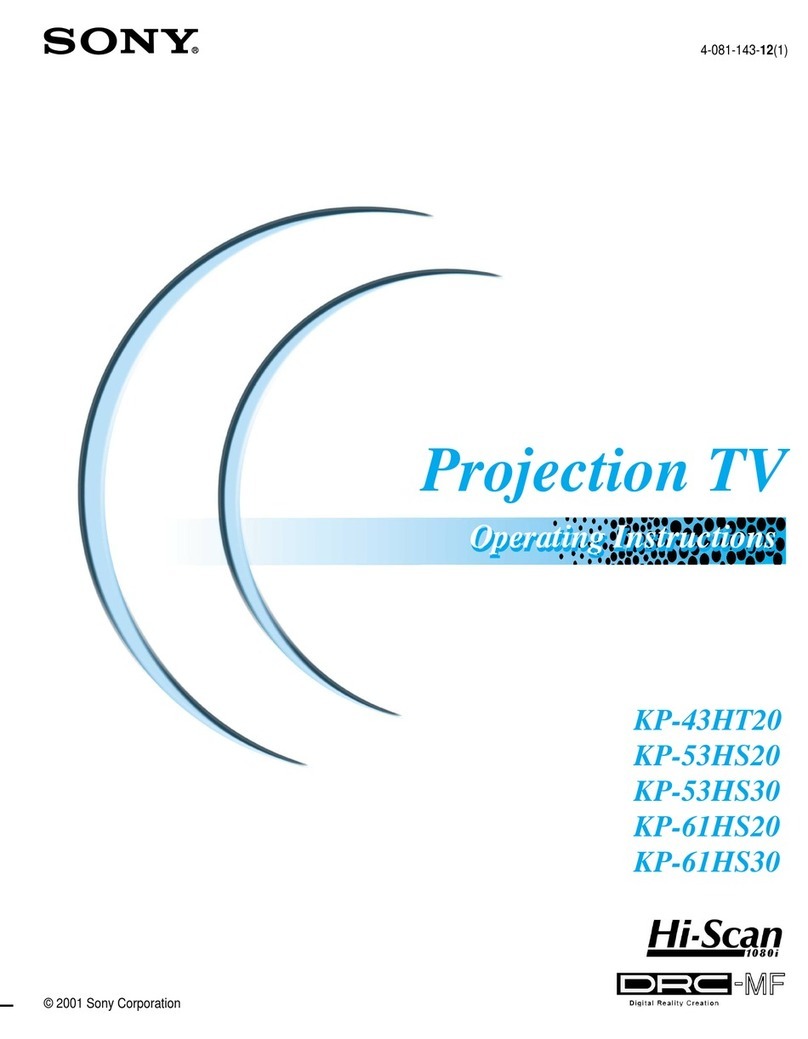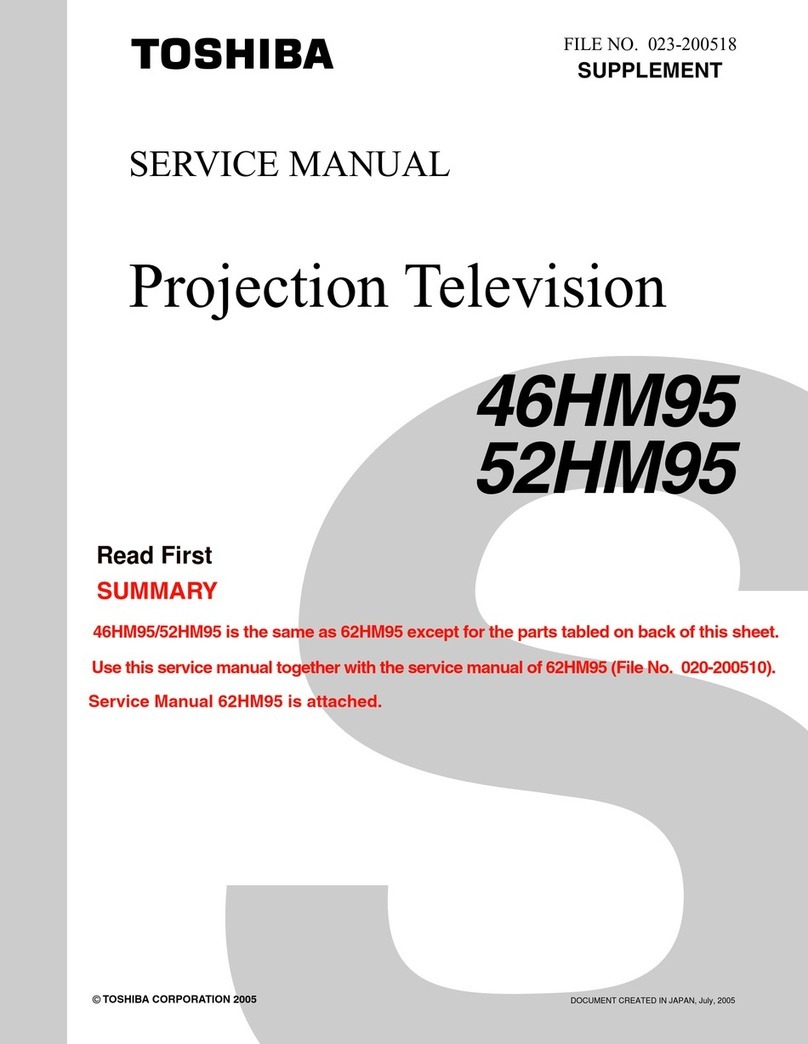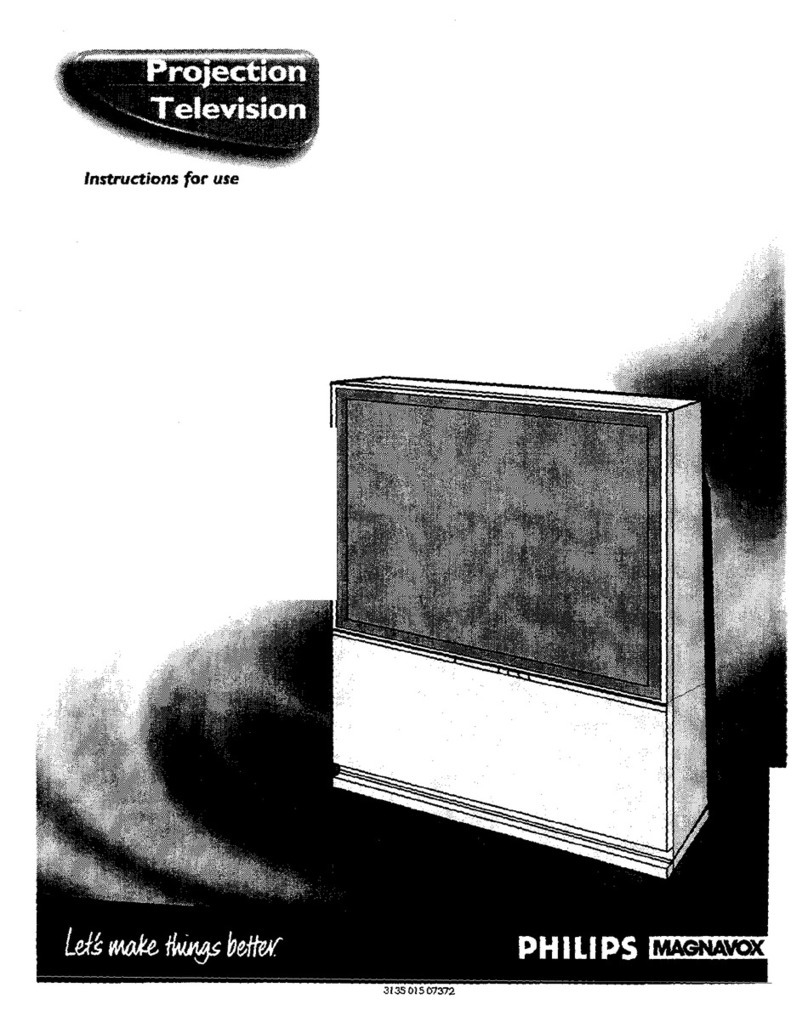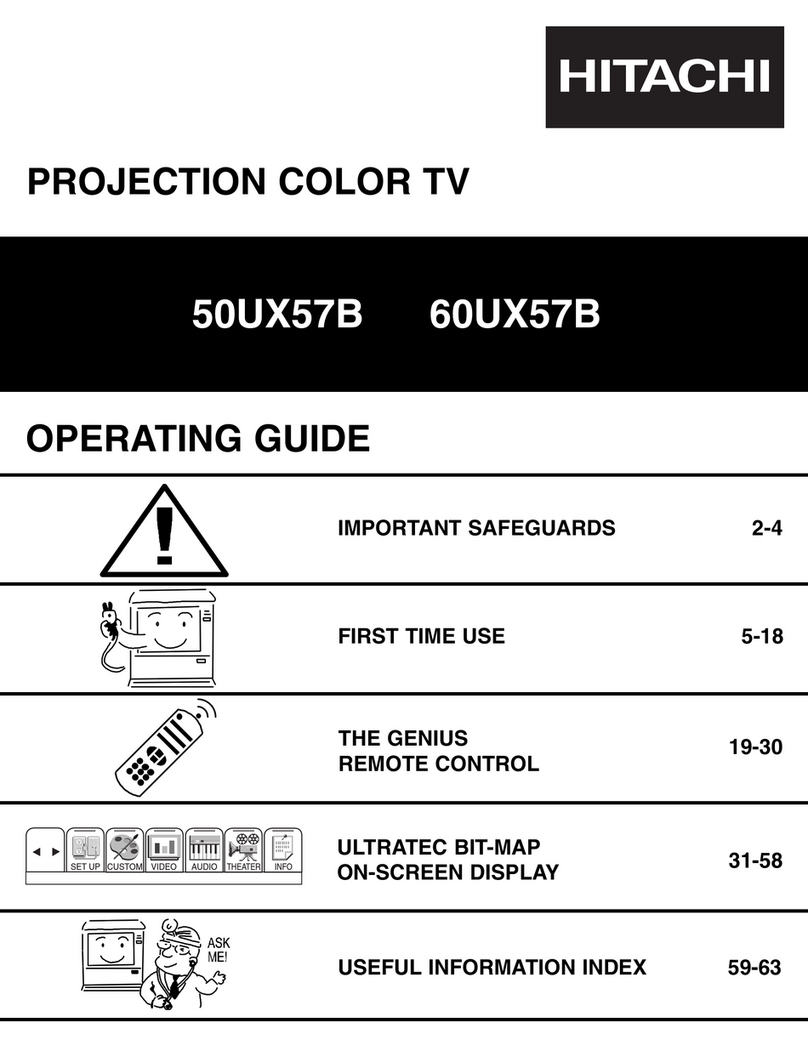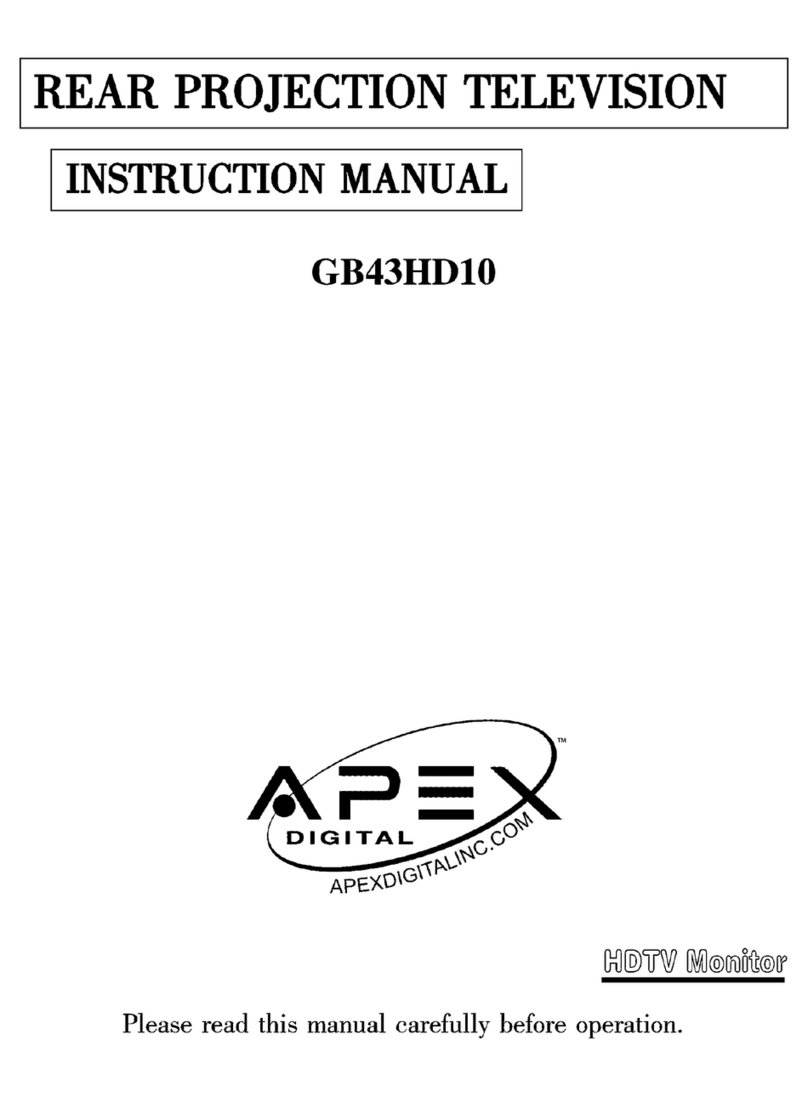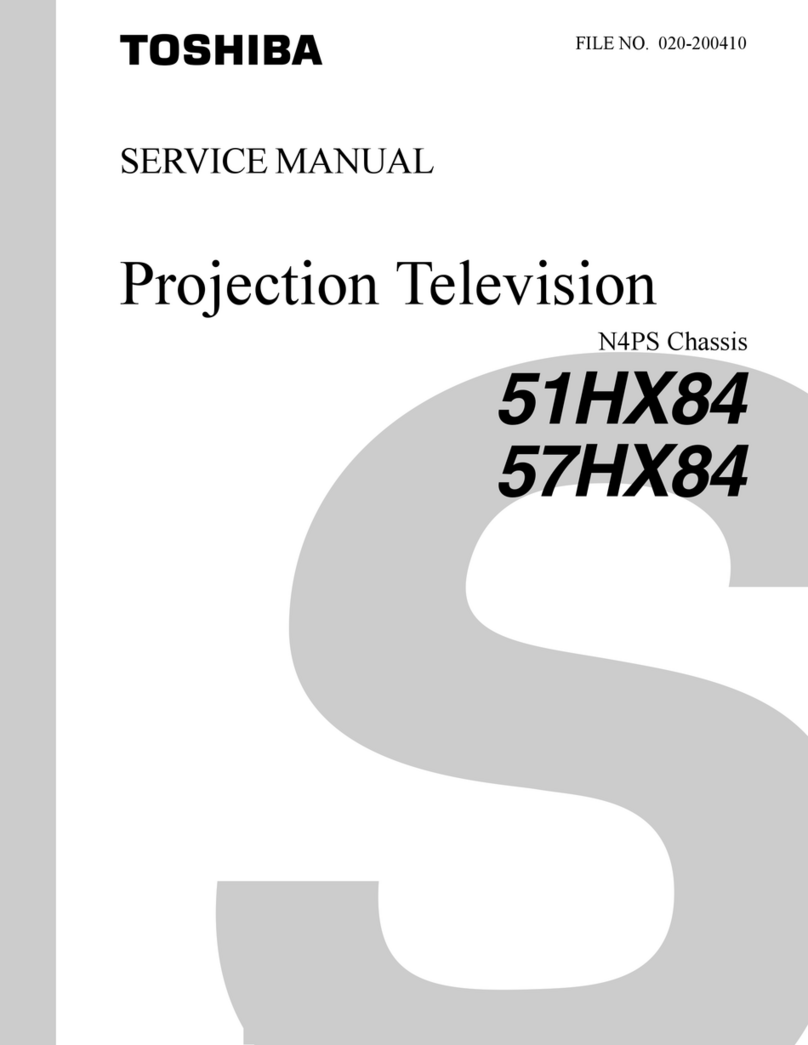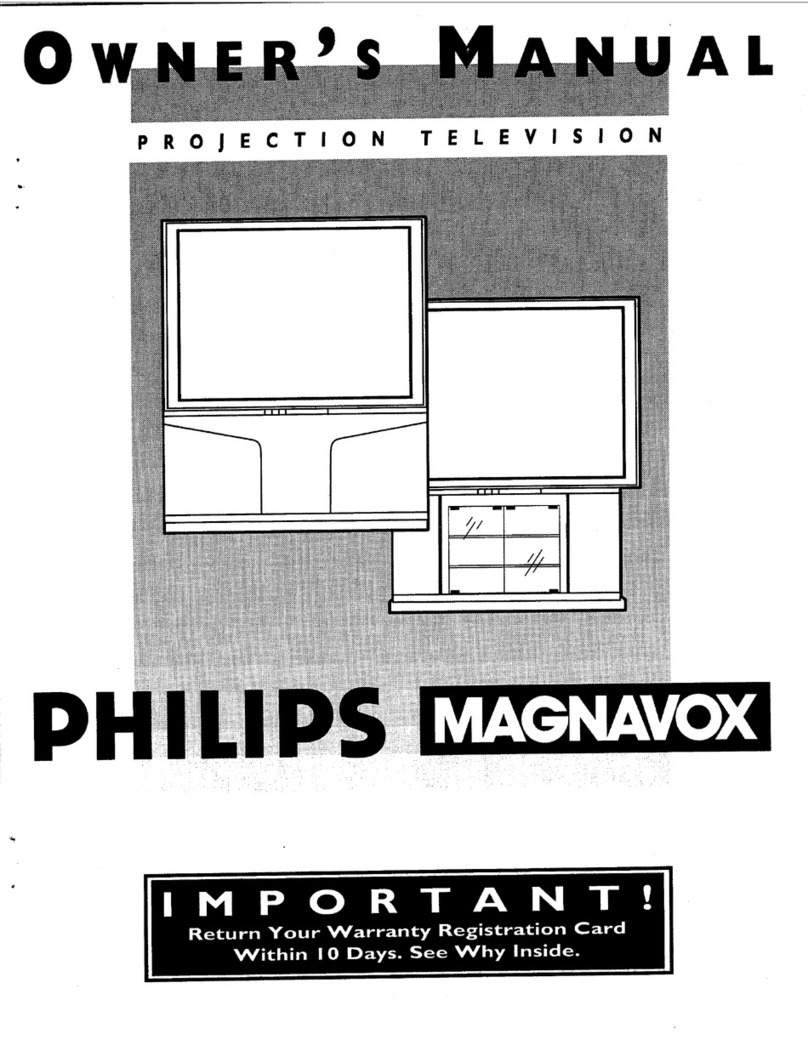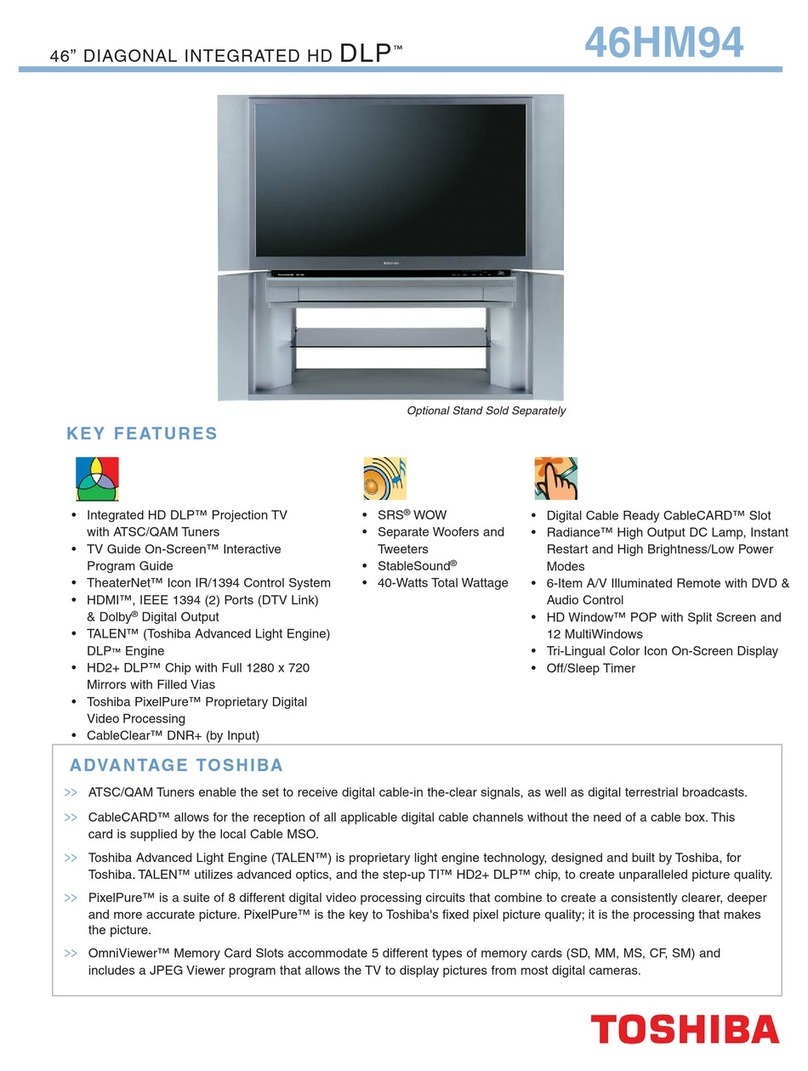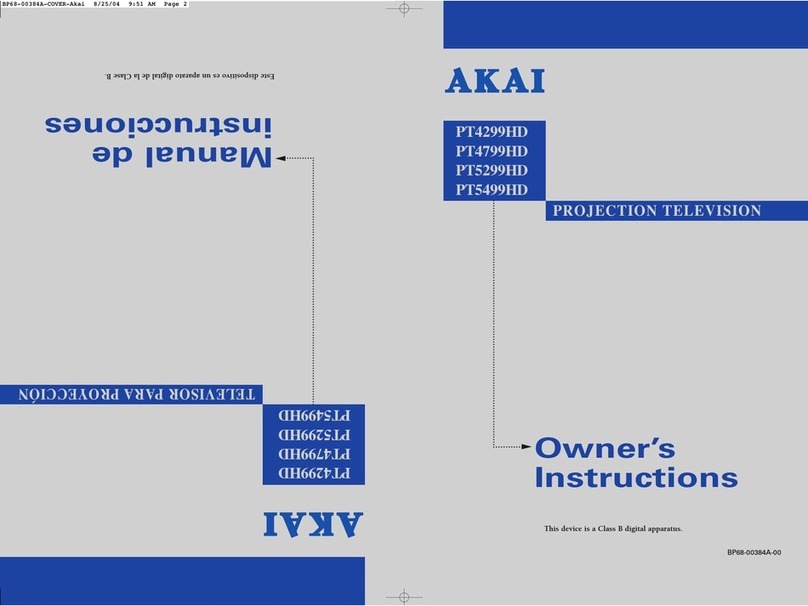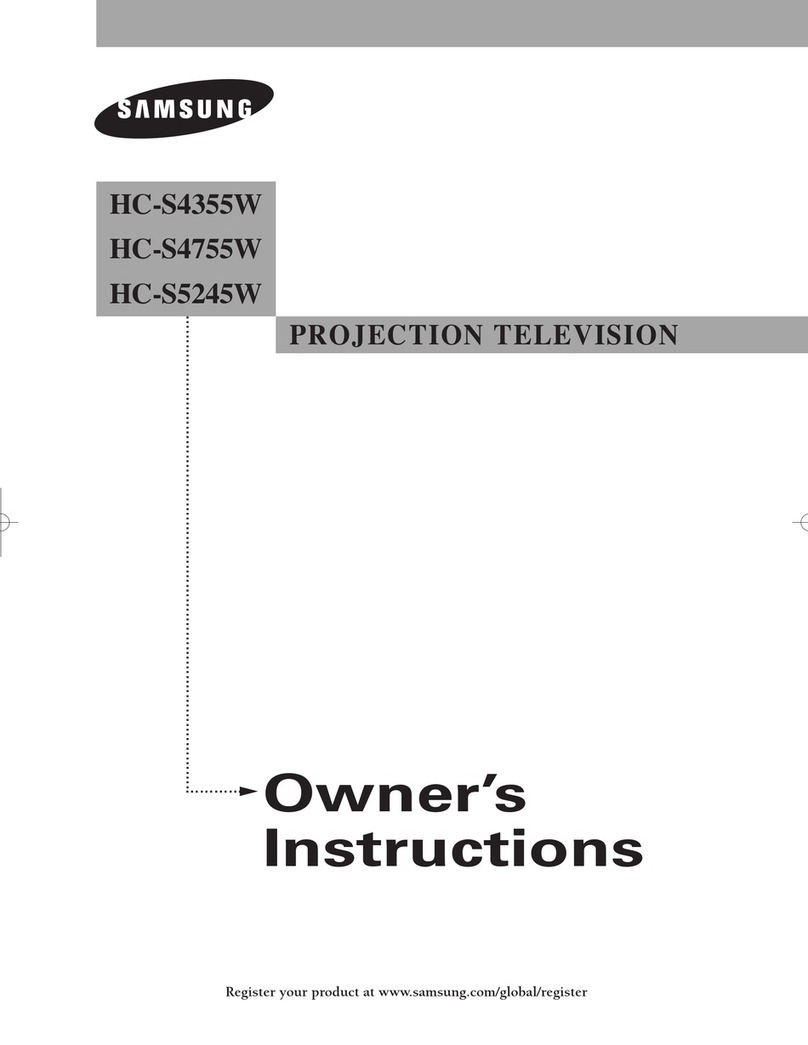Daewoo DSJ-6000LN User manual

Service Manual
LCD PROJECTION TV
(HDTV MONITOR)
CHASSIS : SJ-210
Model : DSJ-6000LN
S/M No. : DSJ210BEF0
Nov. 2002
DAEWOO ELECTRONICS Corp.
http ://svc.dwe.co.kr

- 1 -
1. Safety precautions 2
2. Product specification 4
3. Remocon specification 5
4. Adjustment 7
5. Circuit Manual 11
6. Trouble shooting 27
7. Block diagram 35
8. Exploded View 36
9. Connection diagram 37

- 2 -
1. Safety precautions
CAUTION : Do not attempt to modify this product in any way. Unauthorized
modifications will not only void the warranty, but may lead to your being liable for any resulting property damage or
user injury.
Service work should be performed only after you are thoroughly familiar with all of the following safety checks and
servicing guide-lines. To do otherwise, increases the risk of potential hazards and
injury to the user.
SAFETY CHECKS
After the original service problem has been corrected, a check should be made of the following:
SUBJECT : FIRE & SHOCK HAZARD
1. Be sure that all components are positioned in such a way as to avoid possibility of adjacent component shorts. This
is especially important on those chassis which are transported to and from the repair shop.
2. Never release a repair unless all protective devices such as insulators, barriers, covers, shields, strain relief, and
other hardware have been reinstalled per original design.
3. Soldering must be inspected to discover possible cold solder joints, frayed leads, damaged insulation (including
A.C. cord), solder splashes or sharp solder points. Be certain to remove all loose foreign particals.
4. Check for physical evidence of damage or deterioration to parts and components, and replace if necessary follow
original layout, lead length and dress.
5. No leads or components should touch a receiving tube or a resistor rated at 1 watt or more. Lead tension around
protruding metal surfaces must be avoided.
6. All critical components such as fuses, flameproof resistors, capacitors, etc. must be replaced with exact factory
types. Do not use replacement components other than those specified or make unrecommended circuit modifications.
7. After re-assembly of the set always perform an A.C. leakage test on all exposed metallic parts of the cabinet, (the
channel selector knob, antenna terminals, handle and screws) to be sure the set is safe to operate without danger of
electrical shock. Do not use a line isolation transformer during this test. Use an A.C. voltmeter, having 5000 ohms per
volt or more sensitivity, in the following manner : connect a 1500 ohm 10 watt resistor, paralleled by a 15 mfd. 150V
A.C. type capacitor between a known good earth ground (9water pipe, conduit, etc.) and the exposed metallic parts,
one at a time. Measure the A.C. voltage across the combination of 1500 ohm resistor and 0.15 MFD capacitor.
Reverse the A.C. plug
and repeat A.C. voltage measurements for each exposed metallic part. Voltage measured must not exceed 0.75 volts
R.M.S. This corresponds to 0.5 milliamp A.C. Any value exceeding this limit constitutes a potential shock hazard and
must be corrected immediately.

- 3 -
Safety precautions
GRAPHIC SYMBOLS :
The lightning flash with arrowhead symbol, within an equilateral triangle, is intended to alert the service
personnel to the presence of uninsu-lated" dangerous voltage" that may be of suffi-cienty magnitude to
constitute a risk of electric shock.
The exclamation point within an equilateral tri-angle is intended to alert the service personnel to the
presence of important safety information in service literature.
Fuse symbol is printed on pcb adjacent to the fuse, with " RISK OF FIRE REPLACE FUSE AS
MARKED". The symbol is explained in the ser-vice manual with the following wording or equiv-alent
CAUTION : FOR CONTINUED PROTECTION AGAINST FIRE HAZARD, REPLACE ONLY WITH SAME
TYPE (6.3A, 125V)" and
" ATTENTION: AFIN D’ ASSU UNE PROTECTION PERMANENTE CONTRE LES RISQUES D’ INCENDIE,
REMPLACER UNIQUE-MENT PAR UN FUSIBLE DE MEME TYPE ET DE " 6.3A, 125V" .
SUBJECT : TIPS ON PROPER INSTALLATION
1. Never install any receiver in closed-in recess, cubbyhole or Closely fitting shelf space over, or close to heat duct,
or in the path of heated air flow.
2. Avoid conditions of high humidity such as : Outdoor patio Installations where dew is a factor. Near steam radiators
where steam leakage is a factor, etc.
3. Avoid placement where draperies may obstruct rear venting. The customer should also avoid the use of decorative
scarves or other coverings which might obstruct ventilation.
4. Wall and shelf mounted installations using a commercial mounting kit, must follow the factory approved mounting
instructions. A receiver mounted to a shelf or platform must retain its original feet (or the equivalent thickness in
spacers) to provide adequate are flow across the bottom, bolts or screws used for fasteners must not touch and
parts or wiring. Perform leakage test on customized installations.
5. Caution customers against the mounting of a receiver on sloping shelf or a tilted position, unless the receiver is
properly secured.
6. A receiver on a roll-about cart should be stable on its mounting to the cart. Caution the customer on the hazards of
trying to roll a cart with small casters across thresholds or deep pile carpets.
7. Caution customers against the use of a cart or stand which has not been listed by underwriters laboratories, inc.
For use with their specific model of television receiver or generically approved for use with T.V.’ s of the same or
larger screen size.
Caution for servicing
When the general troubles happen, Remove the back cover of the TV set. But , however if the components (the Air
filter, Lamp, Lamp detect switch, or LCD Engine driver PCB, etc) in the front of TV set is out of order, Remove the
speaker grill and the front panel of the TV set.
Specially, First you have to plug out socket , for exchanging the Fuse of TV set,.
When Lamp driver is operated, the high voltage(13~20kV) is generated from the Lamp. Therefore the person only
who has the enough knowledge for the high voltage must handle it with care.

- 4 -

- 5 -

- 6 -
KEY Button and Function
KEY BUTTON FUNCTION
Remote controller Green - TV in use
Lamp Orange - VCR in use
Red - CATV in use
POWER Use turning on, turning off TV
TV/VCR/CATV TV / Video / Cable Converter
Use to select Use to select channel directly 0~9
channel directly
100 Button Use it when selecting a channel number of over 100
RECALL It displays currently watching TV channel and its input signal.
VCR Function REW, PLAY, FF, STOP, REC, PAUSE.
MENU Use it to make picture adjustment, screen format, sound adjustment, input
selection, and utilities.
TV/ VIDEO Use this function to make video input selection.
It changes in the fallowing sequence
TV VIDEO 1 VIDOE 2 VIDEO 3 DVD TV
PC/DTV PC DTV can be selected alternately.
Use it when selecting either PC or DTV.
Channel/ Volume Use this function to select the channel / to adjust the volume.
PREV It returns to previous channel.
MUTE Use to mute.
SCREEN MODE This feature converts the screen mode each time you press the button
from Normal Bright Soft User
SCREEN SIZE This feature converts the screen size by changing its aspect ratio. Each
time you press the button, it will be change from
Normal Wide Panorama Enlarge(LB) Enlarge(LBS)
DOLBY SOUND This button allows you to choose one of the Pro-logic modes.
Normal Off 3-stereo Wide
SOUND MODE This feature allows you to choose the mode, Each time the button is pressed,
it rotates from Normal Music Movie News User
ADD/ERASE This feature either momorizes the current channel or erases a channel that
has previously memorized.
CAPTION This feature allows you choose the caption. Each time the button is pressed it
rotates from CC1 CC2 CC3 CC4 off
SLEEP This feature is use to set up the time out of automatic turn off..
MTS This feature allows you to select the language while broadcasting.
TV/CATV This button allows you to select the broadcasting alternately.

- 7 -
4-1. Adjustment in Production
1) How to Fix Engine.
You measure the range of screen s shifting after assembling set.
But, in case of the range is over spec ( H : 7mm, V: 3mm, Tilt : 2mm), adjust again in Local CH 8(RETMA) of
the factory.
2) Adjustment H/V Position.
You select PC Mode to receive reference signal of VG-828 (Program #. 954 : 720p Pattern. 990 : Display
Position Pattern)
Note : LCD Panel is 720p.
You can adjust screen size and position in operating User Menu ( Horizontal Size & Position, Vertical Size &
Position).
3) White balance adjustment
Input the signal of VG-828 (Program #. 946(NTSC) White Window Pattern.(20 20)) to Video 1.
Confirm the initial data of PW364 Mode in SVC Menu.
Adjust the White Balance changing R/G/B Gain after setting signal level 100IRE( 255).
How to adjust temperature of color. : X = 0.265 0.01 0.270 0.01.
You can set Luminance level .
Adjust the White Balance changing R/G/B Bias after setting signal level 40IRE( 102).
Input the signal of VG-828 (Program #. 972(1080i) White Window Pattern.(20 20)) to DTV.
Adjust the White Balance changing AD9884 s Register Value(CXA1315A, CXA1315B, CXA1315C) after
setting signal level 40IRE( 102).
Adjust the White Balance changing CXA2101 s Register Value(R-Drive, G-Drive, B-Drive) after setting
signal level 40 IRE( 102).
Confirm the range of White Balance being in limit and measure Luminance value
Set all adjustment after about 5 Min s heatruning
Note : Lamp wattage converted automatically from 160W to 130W after 3 min.
Heatrun must be operated after inputing White_Pattern, (no concerned ‘No Signal’)
Note : You select ‘White_Pattern’ in ‘Test Pattern’ of SVC Menu.
You select Screen Size is ‘Wide’ and Screen Mode is ‘Normal’.

- 8 -
4-2. SERVICE MODE
To operate Service : Press the USER Remote controller in order starting with CH Up Mute RECALL
Mute (You can operate in case INPUT is TV mode, or being input signal)
Service Mode
* PW364 (Adjusting Brightness Contrast and White Balance of full Iinput)
Item Initial Value Description
S Bright 64 Screen Brightness Fixing Value
S Contrast 64 Screen Contrast Fixing Value
R Bias 63 Red Color of Low level signal Adjusting Value
G Bias 63 Green Color of Low level signal Adjusting Value
B Bias 63 Blue Color of Low level signal Adjusting Value
R Gain 63 Red Color of Low High signal Adjusting Value
G Gain 63 Green Color of Low High signal Adjusting Value
B Gain 63 Blue Color of Low High signal Adjusting Value
SVC MAIN (Initial Data of the Service mode)
PW364 (Adjusting Brightness Contrast and White Balance of full input)
AD9884 (Adjusting Brightness Contrast of DTV/ PC input)
CXA2101 (Adjusting Brightness Contrast and White Balance of DTV input)
VPC3230 (Adjusting Brightness Contrast of TV / VIDEO/DVD input)
Test Pattern (Displaying in order R G B W BLK
Lamp Watt (Adjusting Lamp Wattage 160W or 130W)
ENG Control (Adjusting LCD ENGINE UNIT)
Use Time (Total usage time of LCD panel)
Factory Set (operating Initalization)
DSJ6000LW200209181500 (Model name, micom version)

- 9 -
AD9884 (Adjusting Brightness Contrast of DTV/ PC input )
CXA2101 (Adjusting Brightness Contrast and White Balance of DTV input)
R Gain 148 Fixing Value RED MIN 148
G Gain 148 Fixing Value RED MAX 148 Reading velue
B Gain 148 Fixing Value GRN MIN 148 automatirally
CLP PL 4 Fixing Value GRN MAX 148 accorling to
CLP DR 4 Fixing Value BLU MIN 148 adjustment state
Phase 15 Fixing Value BLU MAX 148
ITEM Initial Value Description
CXA1315A 42 Adjusting Red Color of Low level signal Adjusting Value
CXA1315B 40 Adjusting Green Color of Low levelsignal Adjusting Value
CXA1315C 40 Adjusting Blue Color of Low level signal Adjusting Value
ITEM Initial Value Description
Picture 63 Contrast Fixing Value
Bright 8 Brightness Adjusting Value
R Drive 22 Adjusting Red Color of High level signal Adjusting Value
G Drive 18 Adjusting Green Color of high levelsignal Adjusting Value
B Drive 16 Adjusting Blue Color of high level signal Adjusting Value
BLK BTM 15 Fixing Value
VPC3230 (Adjusting Brightness Contrast of TV / VIDEO / DVD input)
ITEM Initial Value
Sub Bright 0 Adjusting Value
Sub Contrast 20 Adjusting Value
Test Pattern
R => G => B => W => BLK
Lamp Watt (160W is 25% brighter than 130W but lifetime of Lamp is shorter)
160W
130W
ENG Control (Adjusting LCD ENGINE UNIT )
GAMMA (NORMAL, Natural1, Natural2) : NORMAL(NO GAMMA compensation ),
NATURAL1=NATURAL2
ROTATION Scren Rotation (0, 90, 180, 270)
COLOR Screen s color compensation
sub CPU sub CPU s initalization in Engine Unit

- 10 -
TEMP Detecting the femperature in the inside of ENGINE
V-T Engine V-T compensation
*Use Time : Total usage time of LCD panel
*Factory Set (Operating Initalization)

- 11 -
1. Specification / Feature
1-1. Product Specification
1-2. Product Feature
1-3. General Block Diagram
2. Power Supply
2-1. Summery
2-2. Block Diagram
2-3. Power structure
2-4. Power Action manual
3. Sound & Audio Amp
3-1. Summery
3-2. I/O Specification
3-3. Block Diagram
3-4. Action Manual
4. Video
4-1. Summery
4-2. Block Diiagram
4-3. Video Circuit Manual
4-4. *IF and Video Manual
5. Engine Drive
5-1. Summery
5-2. Block Diagram
5-3. Action Manual

- 12 -
1.Specification / Feature
1-1.Product Specification

- 13 -
1-2.Product Feature
TV Turn on/ off : The Lamp feature
When the main power lamp flickers on green, the screen will gradually turn on. During this instance, the power
button will not operate. When the process is completed, the main power lamp lights on green.
It is LCD-Projection TV characteristics that it takes a little while for the video to be displayed on the screen
when it is turned on. This is not malfunctioning; thus, please be patient and wait for a moment.
The degree of brightness will decrease insignificantly after 3 minutes is passed. This is not a breakdown; it is
only using a power saving process to maximize the lamp s lifetime. (Lamp watt : 160W -> 130W)
When the power buttons are pressed, the main power lamp may flicker in green, but the secondary power lamp
may flicker in red and orange alternately. In this case, the TV s main power has been erroneously pressed, or
has been turned off improperly by a power stoppage or by any other reason. However, please wait for an
instant, and the TV will be back on (the latest 1min. 30sec.) since this is not a malfunctioning of the product.
Turning off the TV set.
Press the power button on the remote controller or that of the TV set. Audio and Video will be turned off and
the main power lamp will flash. In green at this time. This is not malfunctioning nor an error; it is just a process
of cooling the lamp off. During this time, the power button will not operate. A red light will light up after a
minute.
1-3. General Block Diagram

- 14 -
2. Power Supply
2-1. Introduction
The POWER PCB is composed of 140W Power for 60 LCD PTV(DSJ-6000LN) as well as
the Power that makes 380V and 18V primary voltage for Ballast.
2-2. Block Diagram(attach)
2-3. Power Supply Component
(1) Input Power : 100V ~ 240VAC, 50/60Hz
(2) Consumption Power : 270W
(3) Power Supply for the secondary side : See the table below.
No. location voltage Function Current remarks
1 T802 D5V Main and Video/Engine Power 1,000mA F/B Line
2 T802 33V Tuning B+ 3mA
3 T802 A5V Main and Video Power 1,000mA
4 T802 12V Main and Video Power 300mA
5 T802 9V Main and Video Power 80mA
6 T802 18V Ballast and PFC Control Power 150mA Primary
7 L805 380V Ballast Power 470mA Primary
8 T802 17.5V Engine Power 300mA
9 T803 7V/10V Engine Fan Power 1,000mA 10V (more than 45 degree
of Engine temperature
10 T803 +15V Audio Power 3,000mA
11 T803 -15V Audio Power 3,000mA
12 T801 ST5V Stand-By Power 600mA
2-4. Description of Operation
(1)Power Supply and Stand-by Power
(1-1) The voltage coming through Bipolar Power Code (PC801) passes through the
Line Filter composed of EMI Filter (L801, L802), X-Capacitor (C801, C803,
C806), and Y-Capacitor (C822, C823) and is rectified and smoothed in the Bridge
Diode (D803, D806, D831, D832) through the Mimetal that is the P303E
Temperature Sensor (Power OFF when Lamp Temperature 125 ~ 135).
(1-2) The smoothed voltage is supplied to the TOP232P that is STAND-BY POWER
IC(1804), and the TRANS secondary winding supplies STAND-BY Power (5V)
for U-COM.

- 15 -
(2) MAIN Power Operation
(2-1) PWR SWITCH ON(HIGH) Signal is supplied from U-COM to the Base of Q804 via
P805M CONNECTOR, Positive Terminal Relay(Y801) is activated, then Starting
Voltage is supplied to the No.4 pin (Vin) of STR-F6656(IC802, IC803) via R836 and
R844.
(2-2) AC Power is rectified in the Bridge Diode(D801), and is applied to P winding of the
TRANS, and reaches 16V of TRANS Auxiliary Winding (No.7 pin), then Control
Circuit is active by the operation of Start Circuit.
(2-3) The winding voltage of the Auxiliary Winding (No.6 pin) is rectified, 18 V is upplied
to 1601(FA5332M) No. 3/16 pins, and the phase of Voltage/Current is compensated,
No.13 Pin Reference Voltage/No. 15 Pin OSC Timing C/R oscillates internally, and
mixed to AND Gate, passes to No.13 pin, and its voltage is elevated to DC380V
from L805 by FET Switching via Debias Stabilization Circuit (Q801/802). The
elevated 380V
is smoothed through Diode(D802), and is supplied to the Ballast via P804B.
(3) Specification of STR-F6656
STR-F6656 is the Hybrid IC for the power of Flyback Converter-type Switching where
Power MOSFET and IC for Control is installed. The characteristics of this IC are parts to
be added are just a few, and various protection functions such as Transient Current
Protection, Transient Voltage Protection, Overheat Protection), and has the Quasi-
Resonance function proper for miniaturization and standardization.
The detailed specifications of this IC is as follows.
Pin Number Symbol Name Function
1 OCP/F.B OCP/F.B OCP detection input and Feed Back
2 S Source MOS FET Source
3 D Drain MOS FET Drain
4 Vin Vin Control circuit voltage Input
5 GND GND Ground
Symbol Function
OVP Over voltage protect
TSD Over temperature protect
<Extra Function>

- 16 -
(3-1) Power Supply for Vin
When Vin Terminal (No.4 pin) voltage that is charged to C821, C830 through the Starting
Resistance reaches 16V(Typ), the Control Circuit inside the F6656 starts to operate. Here,
the Circuit Current is limited to 100 A(MAX) before F6656 operates, so the high Starting
Resistance (47K ,2W) is used. After F6656 operated, the voltage coming out of D
winding of TRANS (T802, T803) is rectified and smoothed, supplying the stable voltage
to the Vin terminal. Here, dl winding is rectified and smoothed via D812, D816, C821,
and C830, and about 16V is supplied to the Vin terminal (No.4 pin) of F6656.
(3-2) OCP/F.B Terminal (Oscillator, Electrostatic Voltage Control Circuit)
Inside the F6656, there is the Oscillator that generates Pulse signal for controlling
electrostatic voltage in the secondary side by turning ON/OFF the MOSFET using the
charging/discharging of C. When AC input is high or Load Current is low, the inflow of
the current of F/B terminal increases, and ON time decreases. The Oscillator has the
Transient Current Protection Circuit (O.C.P. circuit) of Pulse by Pulse type that controls
the oscillator s output by detecting MOSFET Drain current s peak value per every pulse.
(3-3) D/S Terminal (Driver Circuit)
This Circuit is the circuit that charges/discharges the capacity between Gate-Sources of
Power MOSFET by receiving Pulse signal.
(3-4) Latch Circuit
This Circuit is the circuit that stops Power Circuit by keeping the output of the Oscillator
to LOW when the Over Voltage Protection Circuit (OVP) and Overheat Protection Circuit
(TSD) operate. The Sustaining Current of the Latch Circuit is 400 A(MAX) when Vin
terminal voltage is 8.5V, so if the current over 400 A is made to flow to the Vin terminal,
the Power Circuit keeps normal. This circuit activates the Latch Circuit only when OVP,
TSD Circuit operates or when external signal input is kept over 10 sec, by setting the
delay time in accordance with Cinside F6656 in order to prevent erroneous operation
due to Noise, etc. Besides, even though Latch Circuit operates, it is operated in
electrostatic power circuit in the Control Circuit so the Circuit Current gets elevated,
decreasing the Vin terminal voltage dramatically. When Vin terminal voltage gets below
Termination Voltage (10V TYP), the Circuit Current increases again, so Vin terminal
oltage decreases. That is, Vin terminal voltage increases or decreases between 10V and 6V
when Latch Circuit operates, it is possible to prevent Vin terminal voltage rising
bnormally. To cancel the Latch Circuit, Vin terminal voltage should be decreased to below
6.5V. Generally, it can be cancelled by turning off the AC power.
(3-5) Overheat Protection Circuit (TSD)
This Circuit is the circuit that operates the Latch Circuit when the Frame
temperature exceeds 150 degrees (TYP). In this circuit, the real temperature detection is

- 17 -
carried out in the Control System, but MOSFET as well as Control Circuit element is on
the Frame, so the circuit operates same for the overheat of MOSFET.
(3-6) Transient Voltage Protection Circuit (OVP)
This Circuit is the circuit that operates the Latch Circuit when the Vin terminal voltage
exceeds 22V (TYP). Basically, this circuit protects Transient Voltage, but the Vin
erminal is supplied from the TRANS Auxiliary Winding, and this voltage is roportional
to the output voltage, so it operates when the secondary side out is transient voltage such
as when Control Circuit is open.

- 18 -
Partition NAME DESCRIPTION
SIF SIF Signal from TV TUNER
Sound NTSC L/R The Selected Audio signal of 3 input Video
INPUT DVD L/R, DTV L/R The Audio signal of the DVD & DTV
PC L/R The Audio signal of the PC
I2C SCL, SDA
The controlling I2C signal of SOUND IC & DOLBY IC
MAIN L/R The Audio signal L/R
C The Audio signal Center
Sound W The Audio signal Woofer
SL/SR The Audio signal SURROUND L/R
HP L/R The Audio signal HEAD_PHONE
MON L/R The Audio signal MONITOR
OUTPUT
VOL L/R Volume control L/R SPEAKER
VOL C Volume control CENTER SPEAKER
Control VOL W Volume control WOOFER SPEAKER
VOL SL/SR Volume control SURROUND L/R SPEAKER
A_MUTE AUDIO MUTE
3. Sound & Audio Amp
3-1. Introduction
Sound Processor is composed of Switching that selects signal proper to the Select Mode among
Sound Signal of the Video Input (SIF, DVD, Input 1/2/3) and the Sound Signal of Graphic
(DTV, PC); and Signal Processor that generates Sound Signal (C, W, SL, SR) which is Dolby
decoded through MAIN L/R Sound Signal and IIC(SCL/SDA) Interface. Besides, it is composed
of Amplifier that amplifies the signal generated by Volume Control Block to the sound signal
proper for speaker capacity.
3-2. I/O Description
(1) Sound Processor

- 19 -
3-4. Description of Operation
Sound Processor is composed of Switching that selects signal proper to the Select Mode
mong Sound Signal of the Video Input (SIF, DVD, Input 1/2/3) and the Sound Signal of
Graphic (DTV, PC); and Signal Processor that generates Dolby Prologic Sound Signal via
Sound DSP. In the VIDEO the SIF signal is received from TUNER in MSP3440G (SOUND
PROCESSOR IC) generates sound signal L/R. Besides, Among the Sound Signal (NTSC
L/R: VIDEO_1/2/3 Sound Signal L/R selected from the TUNER Sound Signal L/R,
CXA1855 (VIDEO SWITCHING IC), and DVD Sound Signal, a proper sound signal is
selected, then it is outputted to MAIN L/R. In the GRAPHIC, a proper signal is selected in
DPL3519A among the sound signal of DTV and PC, and outputs to MSP3440G, so MAIN
L/R can be selected. Also, D/A converted Sound Digital signal is generated to SERIAL
ATA(IS2_DA, 12S_CL, 12S_WS, I2S_OUT), so Central Sound signal (C) which is DOLBY
PROLOGIC Sound Signal, Woofer Sound Signal (W), and Surround Sound signal(SL/SR) is
generated.
Partition NAME DESCRIPTION
INPUT SOUND PROCESSOR Audio signal (the excepted HP L/R, MON L/R)
L/R Output L/R SPEAKER
OUTPUT C Output CENTER SPEAKER
W Output WOOFER SPEAKER
SL/SR Output SURROUND L/R
3-3. Block Diagram
Other manuals for DSJ-6000LN
1
Table of contents
Other Daewoo Projection TV manuals

